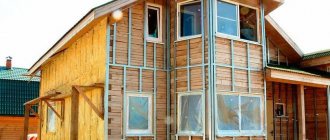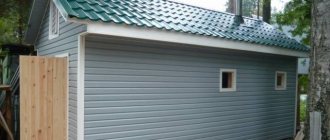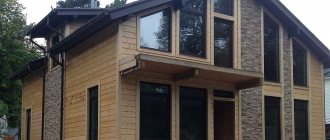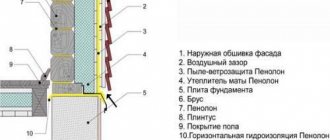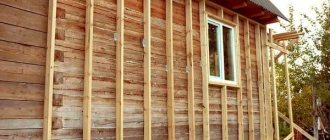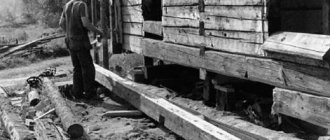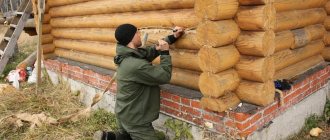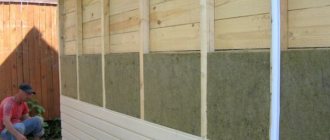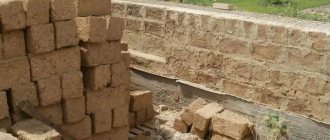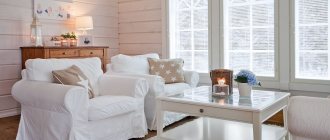Houses made of timber, due to their environmental friendliness, are a popular option for private construction. But although they heat up quickly enough and have good thermal insulation properties, insulating a log house is an urgent need for most households.
Installation of insulation on the walls of a house made of timber Source nd-prime.by
Differences between old and new technologies
Wooden construction in Rus' is a centuries-old tradition. For centuries, houses were built exclusively from log houses, from massive round and semicircular logs, the thickness of which was sufficient for good thermal insulation. Just like today, the tree dried out over time, and cracks appeared between the logs. But earlier there were other ideas about the beauty of the facade, so ordinary wood moss was used to caulk cracks. It landed in the cracks between the logs and over time reliably filled the entire space between them.
In modern construction, issues of economy come to the fore and force the use of timber, the thickness of which does not always meet the requirements of the developed standards. If the cross-section is insufficient, complete freezing occurs in winter, which means that the walls of the house are not able to retain heat. In addition, over time, the wood begins to dry out, causing heat loss to increase even more.
This is what a timber wall looks like after the wood has dried Source bredmozga.ru
Possible mistakes
When insulating, several mistakes are possible:
The most important mistake is to insulate the house not from the outside, but from the inside. This error leads to a decrease in the area of the house and freezing of the walls. If the insulation is installed inside the house, then the heat does not reach the facade and the walls freeze. The dew point moves inside the walls. Condensation appears. The walls, being constantly in a damp state, are destroyed, the life of the house is reduced;
- using insufficient insulation. According to the manufacturer's instructions, good insulation requires a certain density of materials. If the instructions are not followed, the quality of insulation will be low, the insulation will “slip” over time, and heating costs will increase;
- incorrect installation. Due to the loose fit of the insulation and the presence of gaps between them, the effectiveness of thermal insulation decreases;
- no attention is paid to thorough preparation of the foundation.
- incorrectly selected insulation thickness. The thickness depends on the region of residence, the material of the walls and their thickness, and the presence of a basement.
Advantages and disadvantages of wall insulation in a log house
Thrifty owners are looking for ways to properly insulate a house made of timber so that they can spend less money on heating in winter. This can be done in two main ways: from the inside and from the outside, and external insulation is preferable for a number of reasons.
Features of insulation from the inside
With internal insulation, the positive effect of heat saving is offset by the disadvantages:
- Part of the usable area is inevitably lost due to the installation of a frame under the insulation.
- The thermal insulation layer hides the “living” wooden walls and the rooms lose their unique charm.
- Due to external winter cooling of an unprotected wooden wall, the dew point moves into the internal insulation. Condensation occurs, mold appears, and it is difficult to control the condition of the wood.
Video description
What happens to the wall if the insulation is not properly insulated from the inside - in the video:
Insulation of walls from the outside: advantages and disadvantages of the method
Most often they resort to it, keeping in mind the obvious advantages compared to internal insulation:
- The usable area of the internal space is preserved;
- External work does not change the family's daily routine.
- The facade of the house is reliably protected from sudden temperature changes, which extends the life of the building.
- The correct selection of materials does not disturb the microclimate of the rooms (the house “breathes”).
- You can decorate the facade to your liking or improve the appearance if the wood has darkened over time.
- If the technology is followed, the wood will be additionally protected from damage.
- Ease of monitoring the work of the construction team.
The main disadvantage of external insulation is the need to carry it out in good weather; in cold and damp weather there is no point in doing this.
See also: Catalog of companies that specialize in insulating country houses.
Table: Technical characteristics of mineral wool and extruded polystyrene foam
| Characteristic name | Mineral wool | Extruded polystyrene foam |
| Compressive strength at 10% linear deformation, MPa | 37-190 (+/- 10%) | 28-53 (+/- 10%) |
| Water absorption by volume over 24 hours | less than 0.4 | 0,2-0,4 |
| Self-combustion time, no more, s | non-flammable material | poisonous gases dissipate |
| Fire technical characteristics according to SNiP 21-01-97 | NG, T2 | G1, D3, RP1 |
| Operating temperature range, °C | -180 to +650°С At t ≥ 250°С the binder evaporates. Melts at 1000°C | -50 to +75 °C At 200-250 °C heat toxic substances decompose |
| Vapor permeability coefficient, mg/(m.p. Pa) | 0,31-0,032 | 0,007-0,012 |
| Safety | + | — |
| Thermal resistance | 0,036-0,045 | 0,03-0,033 |
| Soundproof and windproof | + | + |
| Moisture resistance | + | + |
| High load resistance | — | + |
| Maintaining stable dimensions | — | + |
| Durability | 50 years (actual - 10-15 years) | 50 years (actual - more than 20 years) |
| Ease of use | + | + |
| Flammability | + | — |
Three main insulation methods
Any insulation of walls involves attaching a layer of insulation and structures holding it to it. Several methods have been developed for this purpose and each of them has its own advantages and implementation features.
The principle of wall insulation is the creation of an additional protective “pie” Source lestorg32.ru
Hinged ventilated facade
This technology itself was developed as a decoration for the facade of a house, but since the installation procedure involves attaching a layer of mineral wool or a similar material to the wall, this method can be considered as insulation.
Advantages of using ventilated facades:
- Long service life (up to 50 years), excellent heat and sound insulation.
- Easy to install.
- Wide selection of facing materials in various colors.
- The dew point moves outward.
Installation technology:
- Pre-treatment of lumber is carried out with compounds that prevent rotting and make the tree unattractive to insects.
- A sheathing is attached to the outside of the house, onto which a sheet of hydro- and wind protection is placed. Air circulates freely in the space between the sheathing slats, due to which condensation or moisture that appears in other ways will be removed from the insulation.
- The sheathing is leveled with a plumb level.
- Next, slats are placed on the sheathing, the distance between which should correspond to the width of the heat insulator. The height of the slats is selected accordingly - for central Russia it is recommended to use insulation with a thickness of at least 70 mm.
A feature of a ventilated façade is that a gap is left between the insulation and the cladding Source builderclub.com
- Insulation mats are placed between the slats, secured with dowels.
- Then bars with a thickness of at least 5 cm are additionally stuffed onto the slats so that there is always a gap between the insulation and the cladding.
- Cladding (siding) is installed.
Laying insulation under siding.
There are practically no fundamental differences from the previous technology - insulation is also used here and a decorative coating is also used on the outside. But if the very name of the ventilated facade indicates the place of its use, then in any case the entire house is covered with siding.
Installation nuances taking into account the selected material:
- The distance between the slats is set equal to the width of the mat if foam or sheet extruded polystyrene foam is selected.
- The distance between the slats is set to 10–15 mm less than the width of the mat if mineral wool is used. This must be taken into account when calculating the amount of mineral wool.
- According to the technology, wool slabs are mounted by surprise; polymer slabs are placed in cells, the joints are treated with polyurethane foam.
- When using mineral wool, a waterproofing layer (diffuse membrane) is additionally installed on top. It is not needed when using fiberglass or polystyrene.
Covering a log house with siding Source stroyfora.ru
Polyurethane foam spraying method
The principle of this technology is clear to anyone who has seen how they work with polyurethane foam. The difference here is that the volumes of material required to create a thermal insulation cushion are much larger, so a spray gun using compressed air from a compressor is used to process polyurethane foam. Advantages of the technology:
- Easy to use and high speed application of thermal insulation mixture on large surfaces.
- Excellent adhesion (cohesion) with most building materials, long-term preservation of properties.
- Environmental friendliness, fire resistance and protection against rotting of the treated surface.
Spraying of insulation can be done on any prepared surface Source keeninsulation.com
See also: Catalog of projects of houses made of timber presented at the exhibition “Low-Rise Country”.
Ventilated facade
The installation of a ventilated facade consists of 3 stages:
- preparatory;
- the main one, when thermal insulation work is carried out;
- finishing - the building is sheathed with siding, imitation timber, block house, etc.
Preparatory work
Before starting insulation work, a visual inspection of the facade is carried out, during which damage to the wood due to rot is revealed, which is unlikely, and insects (bark beetles, wood borers, longhorned beetles and woodcutter beetles - the problem occurs), gaps between the crowns, violations in the fastening systems of window and door blocks, unevenness. After identifying all the defects, they begin to eliminate them:
- areas damaged by rot are removed with a plane or an ax;
- Wood infested with pests should ideally be removed. But if such a disaster happened in an already assembled log house, do not despair. After all, these are not termites - they will not be able to completely “devour” the house. In such cases, experts advise drilling holes in the timber at an angle to the horizontal to a depth of ¾ of the timber, in increments of 40-50 mm horizontally and vertically, and then using a syringe to pour insecticides into it. Repeat the operation several times, then tightly seal all inlet and drilled holes with sealant. The larvae will live for some time, but the cycle of their transformation into adult beetles will be disrupted - adult individuals simply will not be able to get out of the wood.
- the cracks in the corners of the building and between the crowns are caulked;
- the fastening of door and window blocks is strengthened;
- protruding places (typical of profiled timber) are removed using a chisel or plane, less often - an ax;
- the outside of the wood is treated with antiseptics, and you don’t just need to spray it for show, but thoroughly treat it 2-3 times;
Attention: impregnations have appeared on sale that also contain fire retardants, which simplifies the wood processing process.
- the sheathing is installed. To do this, the beam is attached to the wall vertically with self-tapping screws. The distance (step) between the slats is equal to the width of the insulation minus 2-3 cm for installing it sideways.
Insulation
Basalt mats are installed between the sheathing strips. Some experts additionally attach them to the wall with special dowels with an umbrella head or a roundel washer in 5 places: in each corner and one in the center. Practice shows that the insulation holds up well even without additional fastening.
The insulating layer is covered with an overlapping windproof membrane (type A or AM). Attached to the sheathing with a stapler. There is no need to be zealous - the final fastening will be done with counter batten slats. The membrane joints are sealed with tape.
Finishing
The counter-lattice strips are screwed onto the lathing slats, on top of the membrane, with self-tapping screws, onto which the finishing trim will be attached.
Types of insulation
The choice of insulation for outdoor work is quite wide and each of them has distinctive features that must be taken into account when choosing:
Mineral wool
Available in three varieties - stone (basalt), glass and slag. All have similar properties: fire-resistant, non-flammable, chemical and biological resistance. Other advantages of the material include vapor permeability, environmental friendliness and high sound insulation.
The downside is that cotton wool attracts rodents and does not dry completely when wet.
It all depends on the skills of the builders, but usually insulating the outside of a house with mineral wool is easier to do using mats than rolls - the latter are not always convenient to deploy on vertical walls.
Laying mineral wool slabs in lathing Source remontik.org
Slab styrenes (foam plastic, polyurethane foam)
Polystyrene foam is the cheapest option, lightweight and porous, with low hygroscopicity and excellent thermal insulation. The main disadvantages are considered to be flammability (releases toxins when burned), fragility and instability when exposed to ultraviolet radiation.
Turnkey service cost
Prices are formed from several parts. Why is a calculation made? An accurate calculation can be made after all measurements:
- location of the house;
- insulation size;
- type of design.
Approximately for 1 m2 of facade insulation you need to pay from 2000 rubles.
Table of average cost of insulation.
| Name of material | Price in rubles per 1 m2 |
| Expanded polystyrene | 920,00 |
| Mineral wool | 1 189,66 |
Video description
In this video we will take a closer look at insulating a house with polystyrene foam. How safe is polystyrene foam?
Extruded polystyrene foam
It has a special porous structure, tolerates low temperatures well and is unsuitable for microorganisms. The material is durable, easy to install (slabs), and does not absorb water. Disadvantages: Highly flammable and releases harmful toxins.
Polystyrene foam and polystyrene foam are similar in appearance Source lineyka.net
Styrofoam
The most economical and lightest. However, it is worth considering that it is much less fire-resistant (let’s be honest - it burns relatively well, but when burned it releases harmful substances). At the same time, it is important to understand that not everything is so scary: previously there were many myths among people that the material itself releases harmful substances that are dangerous to humans. At the same time, many laboratory studies and tests have already been carried out in a variety of conditions - this myth has not received a single confirmation, that is, the material itself does not release anything into the environment. The safety of polystyrene foam is confirmed by the sanitary-epidemiological conclusion No. 03/PM8 of the Moscow Research Institute of Hygiene and the conclusion 01-188 of the Research Institute of Hygiene and Health Protection of Children and Adolescents of the Russian Academy of Medical Sciences, that is, in general, in normal condition the material is more than safe.
When choosing polystyrene foam, we recommend paying attention to the digital indicator of its marking - the higher the number, the higher the density and thermal insulation properties. That is, the 35th brand, 5 cm thick, is more profitable for you than the 25th brand, 10 cm thick. At the same time, oddly enough, the price of the options is hardly noticeable.
Subtleties of insulating timber walls
Insulating a log house from the outside under siding cannot be started whenever you want - before this, the following conditions must be met:
- Work on installing insulation can begin only after the log frame has completely shrunk - often this period can be one and a half to two years.
- It is prohibited to carry out work if the façade has not been treated with an antiseptic. Ignoring this rule will lead to the appearance of fungus and rot.
- Before insulating a house made of timber from the outside, it is necessary to prepare the facade: seal not only wide cracks, but also small cracks. To do this, you can use putty, polyurethane foam or similar materials.
- Good thermal insulation of a log house requires careful selection of material and calculation of its quantity. It is necessary to consider how the thermal insulation material will be combined with the wood of the timber itself.
- To choose the right insulation, you need to take into account the size of the building, the quality of the frame and seams.
Some insulation is installed without lathing Source obustroen.ru
How to make the necessary calculations
To find the thickness of insulation for a house, it is important to know its thermal conductivity coefficient λ and the normalized thermal resistance of the area R.
Let's perform the necessary calculations in 3 steps.
- D is the thickness of the timber. We find the required thermal resistance for pine beams 15 cm thick in the Moscow region using the formula R = d/λ. The thickness of 0.15 is divided by the thermal conductivity coefficient of pine 0.14. The required thermal resistance is 1.071 W.
- Standard thermal resistance, for example in Moscow is 3.28. Find the difference between the largest and smallest value. 2.209W is a heat transfer value that is not up to standard. For your region, you can find data in “SP 131.13330.2012 Construction Climatology”.
- We find the thickness of stone wool using the formula: d = Rt x λ. The thermal conductivity coefficient of stone wool is 0.042 W/ (m °C
d = 2.209 x 0.042 = 0.092 m. We round the resulting value. It turns out that the thickness of stone wool for a log house in the Moscow region is 10 cm.
Tools and materials for thermal insulation of buildings
To insulate a house without being distracted by searching for tools and materials, builders need to prepare the following:
- bubble or laser building level, you can also use a plumb line;
- tape measure, square or metal ruler;
- hammer, construction knife or hacksaw, screwdriver;
- facade dowels, tape, chalk, polyurethane foam, antiseptic;
- dry slats, insulation;
- vapor and waterproofing film;
- material for final cladding.
- sprayer for treating wood with protective compounds
Treating a wooden wall with an antiseptic Source mybesedka.ru
General progress of thermal insulation installation
All steps for insulating a house made of timber using any of the described methods are always schematically the same and are performed in the following sequence:
- to ventilate the first layer of insulation, a sheathing of wooden planks is mounted on the wall;
- a frame is placed on the sheathing to fix the insulating material
- installation of insulation;
- installation of additional sheathing and frame (if double insulation is used);
- laying an additional layer of heat insulation;
- fastening a diffusion membrane, which will provide water and wind protection.
- installation of facade finishing (lining, siding) with an air gap.
Of course, in the end, insulation will hide the beauty of the natural material, but finishing the house with a block house can be a solution.
Ventilation features
After installing the insulation of the room, as a result, the air humidity in the house increases. To eliminate this problem, you can install ventilation. With its use, the microclimate in the room is normalized.
A good place for ventilation is the attic. The entire ventilation system can fit on it. It is also necessary to purchase a fan, it will help the initial air circulation.
